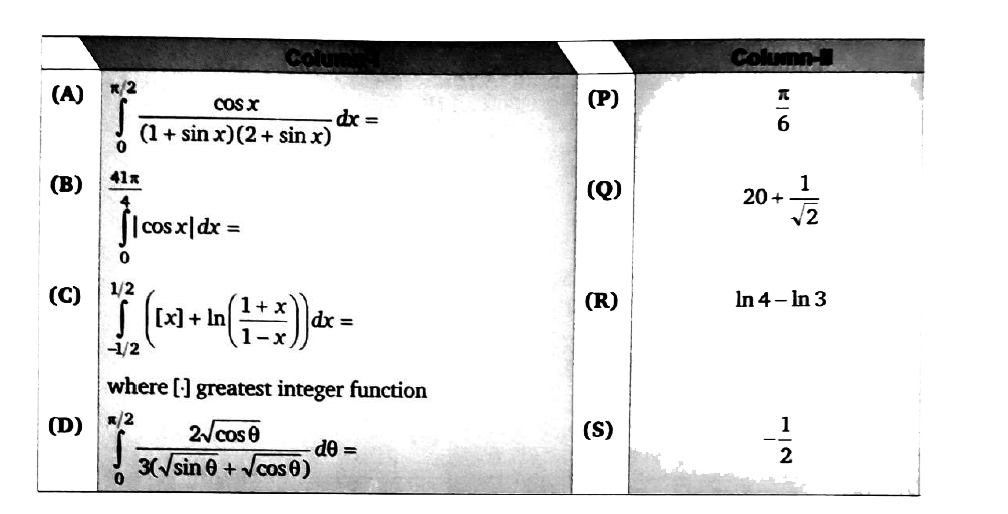Let g(x)=xCeCxandf(x)=∫x0te2t(1+3t2)1/2dt. If L=limx→∞f'(x)g'(x) is non-zero finite number then :
The value of L . Is :
7
32
2
3
The correct Answer is:C
Step by step video solution for Let g (x ) = x ^(C )e ^(Cx) and f (x) = int _(0)^(x) te ^(2t) (1+3t ^(2))^(1//2) dt. If L = lim _(x to oo) (f'(x ))/(g '(x)) is non-zero finite number then : The value of L . Is : by Maths experts to help you in doubts & scoring excellent marks in Class 12 exams.
Updated on:21/07/2023Topper's Solved these Questions
- INDEFINITE AND DEFINITE INTEGRATIONBOOK - VIKAS GUPTA (BLACK BOOK) ENGLISHCHAPTER - INDEFINITE AND DEFINITE INTEGRATIONEXERCISE - EXERCISE (MATCHING TYPE PROBLEMS)
3 Videos
- INDEFINITE AND DEFINITE INTEGRATIONBOOK - VIKAS GUPTA (BLACK BOOK) ENGLISHCHAPTER - INDEFINITE AND DEFINITE INTEGRATIONEXERCISE - EXERCISE (SUBJECTIVE TYPE PROBLEMS)
27 Videos
- INDEFINITE AND DEFINITE INTEGRATIONBOOK - VIKAS GUPTA (BLACK BOOK) ENGLISHCHAPTER - INDEFINITE AND DEFINITE INTEGRATIONEXERCISE - EXERCISE (ONE OR MORE THAN ONE ANSWER IS/ARE CORRECT)
16 Videos
- HYPERBOLABOOK - VIKAS GUPTA (BLACK BOOK) ENGLISHCHAPTER - HYPERBOLAEXERCISE - Exercise-4 : Subjective Type Problems
3 Videos
- INVERSE TRIGONOMETRIC FUNTIONS BOOK - VIKAS GUPTA (BLACK BOOK) ENGLISHCHAPTER - INVERSE TRIGONOMETRIC FUNTIONS EXERCISE - Exercise-5 : Subjective Type Problems
5 Videos
Similar Questions

View Solution∫x+(cos−13x)2√1−9x2dx=1k1(√1−9x2+(cos−13x)k2)+c, then k21+k22= (where C is an arbitrary constnat. )
View Solution∫dx(1+√x)8=−13(1+√x)k1+27(1+√x)k2+C, then:
View SolutionLet y=mx+c be a common tangent to x216−y29=1andx24+y23=1, then find the value of m2+c2.
View SolutionThe complete set of values of x satisfying the inequality sin−1(sin5)>x2−4x is (2−√λ−2π,2+√λ−2π), then λ=
View Solutiong(x),=x^(c)e^(cx) and f(x)=int_(0)^(x)te^(2t)(1+3t^(2))^((1)/(2))dt* if L,=lim_(x rarr oo)(f'(x))/(g'(x)) is non-zero finit number then :,
View SolutionLet f(x)=int_(x^(2))^(x^(3)) for x>1 and g(x)=int_(1)^(x)(2t^(2)-Int)f(t)dt(x<1) then
View SolutionLet f(x)=x2+ax+3andg(x)=x+b, where F(x)=limx→∞f(x)+(x2)g(x)1+(x2)n. If F (x) is continous atx=1andx=−1 then find the value of (a2+b2)
View SolutionLet f(x)=∫x3x2dtlnt for x>1andg(x)=∫x1(2t2−lnt)f(t)dt(x>1), then:
View SolutionConsider the function f(x)andg(x), both defined from R→R
f(x)=x32+1−x∫x0g(t)dtandg(x)=x−∫10f(t)dt, then
The number of points of intersection of f(x)andg(x) is/are:
View SolutionLet f(x) then g(x) be two functions having finite non-zero third order derivatives.
If : f(x)⋅g(x)=1, for all x∈R, then: f'''f−g''g'=
View SolutionLet f(x)=∫x0g(t)dt , where g is a non - zero even function . If f(x+5)=g(x) , then ∫x0f(t)dt equals :
View SolutionConsider the function f : (−∞,∞)→(−∞,∞) defined by f(x) = x2−ax+1x2+ax+1,0<a<2
Let g(x)=ex∫0f'(t)1+t2dt
Which of the following is true ?
View SolutionLet g(x)=xCeCxandf(x)=∫x0te2r(1+3t2)1/2dt.IfL=limx→∞f'(x)g'(x) is non-zero finite number then :
The valur of C is:
View SolutionLet g(x)=xCeCxandf(x)=∫x0te2t(1+3t2)1/2dt. If L=limx→∞f'(x)g'(x) is non-zero finite number then :
The value of L . Is :
View SolutionLet f(0,∞)→(−∞,∞) be defined as f(x)=ex+lnx and g=f−1, then find the g'(e).
View Solution

